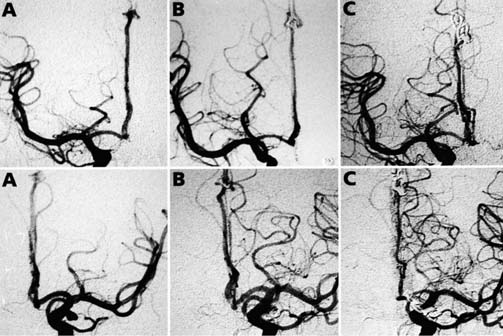2 Diagnosis Aneurysms of the left internal carotid artery and right pericallosal artery Problems and Tactics After severe subarachnoid hemorrhage two aneurysms of the left internal carotid and right pericallosal arteries were diagnosed. Because of poor neurological status and a special pathoanatomical situation neuroradiological therapy was initially performed, with complete closure of the aneurysms. However, after good recovery, the late postinterventional angiogram revealed reopening of both aneurysms. The aneurysms were exposed and successfully clipped via a single frontal interhemispheric approach. Using an endoscope-assisted microsurgical technique, the aneurysms could be completely closed without excessive retraction of sensitive neurovascular structures. Keywords Contralateral approach, interhemispheric exposure, multiple aneurysms A 48-year-old woman was admitted to our neurosurgical department in 1996 after severe subarachnoid hemorrhage. The clinical examination revealed Hunt and Hess grade IV; the initial computed tomography showed no signs of hydrocephalus. The four-vessel angiography showed two aneurysms of the left internal carotid and right pericallosal artery (Fig. 2–1A). Because of the poor neurological status and special pathoanatomical situation with narrow subarachnoid cisterns, neuroradiological interventional therapy was indicated, and complete closure of both aneurysms was achieved. After a long period of intensive care therapy and necessary shunt operation the patient recovered fully and could return to her previous employment. Despite our recommendation, the patient refused postinterventional angiographic. Six years after the bleeding, an angiographic control was ultimately performed that showed reopening of both aneurysms (Fig. 2–1B). The surgical solution was chosen after interdisciplinary discussion with the interventional neuroradiologist concerning the therapy modality that could offer the best and safest aneurysm occlusion. In multiple aneurysm cases, the surgical goal is generally to occlude all aneurysms, if possible, via a single operative approach. In this case, treatment of the right pericallosal aneurysm required an interhemispheric exposure. The planning procedure explored the potential for approaching the left-sided internal carotid artery (ICA) through the same surgical corridor. It was concluded that, by performing a slightly oblique interhemispheric exposure through a limited right paramedian precoronar craniotomy, the aneurysms of the ipsilateral pericallosal artery and the contralateral internal carotid artery could be effectively approached. FIGURE 2–1 (A) Initial, (B) postinterventional, and (C) postoperative angiograms of a 48-year-old woman who suffered from severe subarachnoid hemorrhage. (A) The initial carotid angiograms reveal aneurysms of the right pericallosal and left internal carotid arteries. (B) Note the residual aneurysms 6 years after interventional therapy. (C) Both aneurysms could be completely closed using a single frontal interhemispheric approach. After induction of endotracheal anesthesia, the patient was placed in the supine position, with the head elevated ~15 degrees to facilitate venous drainage. Thereafter, the head was carefully anteroflexed, allowing ergonomic dissection of the internal carotid artery along the restrum of the corpus callosum. After the essential anatomical orientation, the borders of the frontal paramedian craniotomy were defined just anterior to the coronar suture.
Multiple Aneurysms Treated via Frontal Interhemispheric Approach
Clinical Presentation
Surgical Technique
Approach Planning
Surgery
Stay updated, free articles. Join our Telegram channel

Full access? Get Clinical Tree









